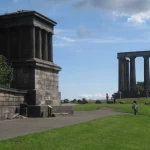Edinburgh World Heritage Status, Scottish Capital Debate, Architecture Development News
Edinburgh World Heritage Site Discussion
Scottish Capital UNESCO Designation, Scotland, UK
post updated 28 July 2021
Edinburgh World Heritage Status News
This page is about Edinburgh World Heritage Status, the UNESCO mission, EWHT, Development, Conservation and so on. It is written by Adrian Welch, and is completely independent of any organisation.
UNESCO Designation for Scottish Capital City Discussion
UNESCO / Edinburgh – Update by Paul Tanner, 30 Jun 2009
As noted on this site back in May Edinburgh World Heritage Status was to be discussed at the annual UNESCO World Heritage Jamboree in Seville 22-30 June
The Scotsman report that UNESCO has passed a resolution calling on Edinburgh City Council and the Scottish Government to scale back the scheme and to introduce controls in a “buffer zone” around the Old Town and New Town heritage site, to protect views. UNESCO asked the UK government to report by 2011 on progress on its recommendations.
The Calton Gate development was also criticised by UNESCO but its future is already uncertain after developer Mountgrange went into administration.
UNESCO / Edinburgh – Update by Paul Tanner, 4 May 2009
The full details of the UNESCO report on Edinburgh should become public soon at the annual UNESCO World Heritage Jamboree being held this year in Seville 22-30 June. Previuosly, as I understand it, the UNESCO officials have only made somewhat gnomic statements which left open the possbility of criticism.
Whether the meeting will want another full blown argument is another matter – they still have to decide what to do about Germany which has continued building a bridge at Dresden despite being warned last year that it faced delisting this year if it didn’t stop! Other battles are in progress at Bordeaux and St Petersburg
World Heritage Status Red Herring
As predicted on this site, Edinburgh’s WHS is not threatened (if it was lost UNESCO would lose its leverage, simple). Unesco delegates announced 15 Nov 2008 that the capital’s status was safe.
Inspectors visited Edinburgh w/c 10 Nov. They investigated planned demolition of two listed buildings. But the status of the Scottish capital was declared to be out of danger after UNESCO’s Dr Rossler said the demolition was an “exceptional” situation.
Dr Mechtild Rossler (Unesco World Heritage Centre chief), said she was satisfied with controversial plan to demolish two C-listed buildings at Calton Gate:-
1. former Canongate School
2. part of the Old Sailors Ark building
Dr Mechtild Rossler’s report is due out Jun / Jul 2009. She declared developers Mountgrange had ignored people’s concerns about the project.
She was accompanied to the capital by Professor Manfred Wehdorn (ICOMOS – International Council on Monuments and Sites, see Alan Dunlop’s article at base of this page).
Rossler said: ‘The World Heritage Committee was concerned that the Caltongate development was approved prior to the committee looking at it more closely. That’s why the mission was ordered’.
The visit lasted four days so clearly more information will be released next year in the report. Other projects which might be commented on are as follows:-
Haymarket Development
St James Quarter
Leith Docks
Princes Street Hotel
Comments welcome at info(at)edinburgharchitecture.co.uk
BBC One Breakfast live broadcast
with Neil Baxter (RIAS secretary) + Sally Richardson (Save Our Old Town campaign)
UNESCO / Caltongate – Opinion Piece by Paul Tanner, 1 Sep 2008
Behind the “Hype” of World Heritage
Mr Wilkinson repeats that old mantra:- “If you consider that the list also includes such iconic locations as The Great Wall of China, and the Pyramids of Giza it is easy to see that the status is a great honour”. I would point out that the list also includes such iconic “premier worldwide destinations” as Reichenau Island and the Mehmed Paša Sokolovic Bridge in Visegrad (Ever heard of them?). The reality is that, despite all the hype, the list is very much a curate’s egg of both iconic and run-of-the-mill sites – also that many “iconic” sites haven’t bothered to apply, don’t see the need or even see too many downsides in doing so!
Another ”part truth” statement is “It is not enough to simply be a historic site, for example York and Chester are not World Heritage Sites,….You have to show that your site is unique, with a story that is so compelling it helps us to understand the way all humankind has evolved over time”.
Given similar inscribed sites across Europe I have no doubt that York and Chester could have succeeded if they had lobbied hard enough for it, paid the necessary monies up front to develop acceptable documentation and subjected themselves to UNESCO’s regime of “management plans” and “buffer zones” (in fact York is still considering whether it wants to do so – though whether it really needs it to get enough tourists for its infrastructure to cope with is another matter! Also, since it has left it so late, the list is already pretty oversubscribed with European Medieval towns and Gothic Cathedrals).
Another reason for “missing UK sites” was the early reluctance of the UK government to deal with UNESCO. The first sites were inscribed in 1978 but the first UK site took until 1986 – by which time that well known “premier worldwide destination” Bulgaria had 9 sites (I won’t list them because, despite Mr Wilkinson’s reference to The Great Wall of China, I suspect that few people will have heard of them).
It might be of interest to note that Bulgaria had been on the World Heritage Committee for 8 of the first 10 years whilst the UK didn’t put itself forward/get itself adopted for rotating membership until 2001! The main reason for the UK delay was the Thatcher government’s dislike of the corruption of UNESCO.
I note also Mr Wilkinson’s comment that “Edinburgh is….a member of the Organisation of World Heritage Cities” as if this is some great honour. But then so are 214 others including “premier worldwide destinations” like Andong in Korea and Bosra in Syria – as well as Telford in UK ! But London, New York and Barcelona are not!
Though they could be, since ANY town (not just a “city”) which contains a UNESCO inscribed World Heritage site can join this organisation – for an annual fee! Recent General Assembly meetings of that organization have been in Mexico, Greece and Peru. No doubt Edinburgh sent representative(s) to these since, as per the rules of this august body:- “The mayors of World Heritage Cities that have paid their annual membership fees make up the General Assembly of the OWHC”.
Now Edinburgh has a perfect right to make such decisions and spend such monies as it sees fit to promote itself worldwide but the UNESCO World Heritage list shouldn’t be portrayed as being in some way “above” the grubby realities of politics and money:- “To have a body such as UNESCO make that kind of judgement about Edinburgh is surely the highest accolade possible”.
In fact the criteria for “Universal Value” which must be met in order to gain inscription have proven remarkably flexible over the years and sites which have been rejected as not meeting them reappear magically a few years later as politics or other factors determine! A well prepared dossier can work wonders and the need to share out the spoils across the world and to pay back support from another country in an earlier year often seems to be a major factor. And many sites are not really “Unique” but are what is called “Representative” of a category or type of site – i.e. they just got in first!
So, to state “By definition World Heritage Sites are must-see locations that provide an experience that cannot be found anywhere else” is a great exaggeration. Goodness – sites on the “List” contain as many as 152 current and former cathedrals and there are something like 100 inscribed European towns alone – including many Michelin 1 and 2** towns which you would think twice about leaving the auto-route to see! But not :- Amsterdam, Dublin, Cambridge or many others which also provide “unique experiences”. Indeed Cambridge is quoted as declining to go for inscription because of the downsides (“The Politics of World Heritage” by Harrison and Hitchcock).
The reality is that possibly only around 100 sites are truly world-iconic and “must see” – but these would be equally must-see without UNESCO inscription. The remaining 778 all have their interests but contain a “quality range” down to the mediocre. Indeed the main beneficiaries of membership in tourism terms are these latter who, just as Mr Wilkinson does, try to bask in the reflected glory from the Taj Mahal and Great Wall of China.
The main reason for sites not getting inscribed is not their ability to meet the somewhat flexible quality requirements but their inability/unwillingness to meet UNESCO’s management regime. And the downsides of meeting that regime are becoming clearer particularly to countries whose institutions know more about democracy than UNESCO – ask the good burghers of Dresden currently fighting over a much needed bridge.
Whilst Chinese cities are falling over each other to try to gain inscription (but their local government isn’t exactly renowned for its democratic approach!!) the USA hasn’t had an inscription since 1995 and some potential locations there have actively fought against being considered since UNESCO, with its “stateist” view of the World seems instinctively to distrust privately owned sites.
Inscription has to be paid for by being subjected to control by the likes of Mr Matsuura and pressure groups which leverage UNESCO’s power. Were Edinburgh’s citizens told all this when it was inscribed in 1995 among an outpouring of national pride at being on the same list as the Pyramids?
Edinburgh World Heritage Site – previous opinion piece
Opinion Piece: AJ November 2007 by Alan Dunlop, Scottish architect
World Heritage Organisations
World Heritage Organisations
“Embracing the past; Enhancing the future” is the tag line of Edinburgh World Heritage Trust. A more honest description would be “Embracing the past, Endangering the future.”
According to the charter of EWH, their purpose is “to enhance the outstanding universal values” of Edinburgh as a World Heritage Site. This means that any building proposed within the site, that includes all of the old town and much of the new, faces additional challenge. EWH has no statutory power but the support of Historic Scotland, which does. Although it is part funded by City of Edinburgh Council, it is the city’s planning department that is the target of their letter writing. Usually, projects the EWH don’t like will cost Edinburgh its World Heritage Status.
Like most quasi governmental organisations who “champion” the public cause, EWHT are unelected and its board made up of accountants, consultants, retired planners and conservationists.
There is talk of Glasgow too applying for its World Heritage badge and this would be unfortunate, as the city supports much sound contemporary architecture.
In Bath, a new development proposal by Feilden Clegg Bradley Studios has incurred the wrath of ICOMOS UK, a local chapter of the International Council on Monuments and Sites, yet another unelected heritage body attached to UNESCO.
ICOMOS objects to 2,200 much needed new houses with shops and restaurants on a brownfield site now occupied by redundant gasholders. The architects have an international reputation for well crafted contemporary architecture on sensitive sites. Nonetheless ICOMOS suggest that if their proposal is given planning permission it will cost Bath its World Heritage Status. Where have we read that before?
Who are these people?
ICOMOS is a “forum for 7,000 conservation professionals which promotes the conservation of our cultural heritage.” Its UK members include archaeologists; conservation architects and national trust members. Like Edinburgh World Heritage Trust, it has no legal powers but is supported by English Heritage.
What is extraordinary is that such self selected groups are permitted to quality assure our built environment in the face of statutory, democratic and architectural principles.
By focusing only on the need to protect heritage and seeming to disregard all else, these organisations inhibit the proper functioning of the planning process. Moreover their drive to preserve particular buildings or city areas in aspic is insular, self seeking and regressive.
Cities are living organisms. They need to change and to adapt to different times. It is inherently dangerous to gift their development to small coteries who aim to restrict their growth to the shape of the past.
Alan Dunlop
19 Nov 2007
Opinion Piece by Adrian Welch: UNESCO World Heritage Site Edinburgh
Scottish World Heritage Architecture
Scottish World Heritage Sites
Antonine Wall
Edinburgh city centre
New Lanark
Orkney – neolithic sites
St Kilda
Edinburgh Architecture
RBGE Edinburgh Biomes
RBGE Edinburgh Biomes Construction
Buildings / photos for the Edinburgh World Heritage Site Status Architecture pages welcome




